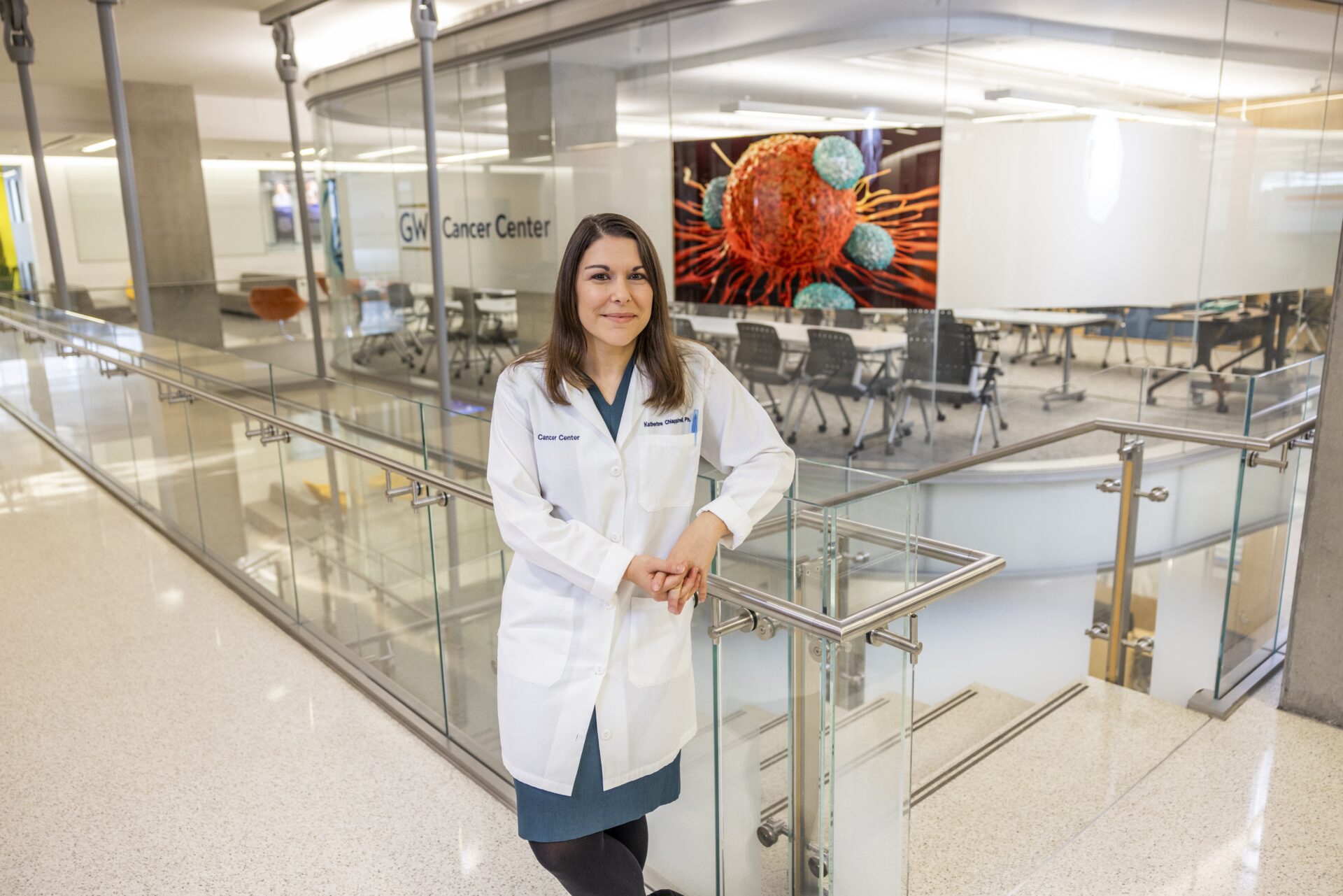Every year, more than 22,000 people are diagnosed with ovarian cancer. Most (85% – 90%) will be diagnosed with a form of epithelial ovarian cancer; and among these, most will be high-grade serous ovarian cancer (HGSOC). Though HGSOC is the most common type of ovarian cancer, there are several different types and subtypes of the disease, and researchers are making promising advances in better understanding and treating many rare ovarian cancers.
Dr. David Gershenson, of MD Anderson Cancer Center, presented the latest updates at our 2020 virtual National Conference.
While there are many more rare types of ovarian cancer, the types discussed in this presentation include:
- Malignant ovarian germ cell tumors
- Ovarian sex cord-stromal tumors
- Mucinous carcinoma (rare epithelial)
- Clear cell carcinoma (rare epithelial)
- Low-grade serous carcinoma (rare epithelial)
As always, the below information is not medical advice. Research results and recommendations are subject to change based on additional scientific studies.
Malignant Ovarian Germ Cell Tumors (MOGCT)
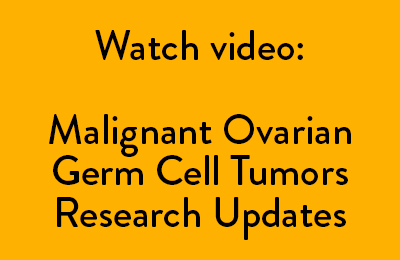
Malignant ovarian germ cell tumors represent less than 5% of all ovarian cancers, and occur primarily in girls and young women in their 20s and 30s. Prior to the 1970s, this type of tumor had a very high mortality rate, but since the introduction of contemporary BEP chemotherapy (bleomycin, etoposide, and cisplatin; a combination often used to treat testicular cancer), the cure rate is 95%. Because this type often affects only one ovary, fertility-sparing surgery is sometimes feasible.
Current research into malignant ovarian germ cell tumors is focused on limiting the extent of surgery, and on reducing toxicity of chemotherapy treatment.
- A low risk international study has enrolled children and adults with Stage 1A and 1B ovarian germ cell tumors that are confined to the ovaries. Patients in the study undergo observation following primary surgery, and receive chemotherapy only if they develop a recurrence. The concept is to try to avoid chemotherapy altogether in patients with very early stage disease. This trial is ongoing, with results expected in about 5 years.
- The same study, this one for patients ages up to 25 years old with Stage 1C-111 malignant ovarian germ cell ovarian cancer, compares the current standard BEP chemotherapy with a bleomycin, etoposide, carboplatin chemotherapy. Carboplatin is thought to be less toxic than cisplatin, and if results of the trial are positive, it will represent a major advancement in lessening short and long-term toxicity.
Ovarian Sex Cord-Stromal Tumors (OSCST)
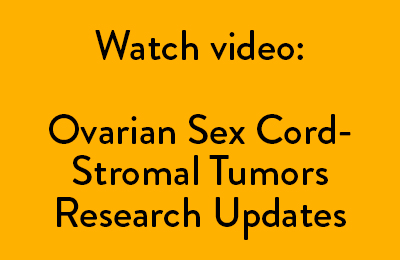
The most common type of ovarian sex cord-stromal tumor is the granulosa-theca tumor, commonly known as granulosa cell tumor (GCT) of the ovary. These represent 2% of all ovarian malignancies. It is often diagnosed in Stage 1, and limited to one ovary, which makes fertility-sparing surgery sometimes possible. Primary and secondary surgeries often play a key role in disease management, with standard post-operation treatment being platinum-based chemotherapy. Though almost all of these tumors have a FOXL2 mutation, there are no drugs that target the mutation, so this is not yet actionable. For patients who recur, molecular tumor testing is usually recommended, and treatment options include secondary surgery, chemotherapy, bevacizumab, endocrine therapy, and clinical trials when available.
Current research into ovarian sex cord-stromal tumors is focused on reducing toxicity of chemotherapy, by abandoning the current BEP regimen for an equally effective, less toxic regimen.
- Following surgery, newly-diagnosed patients with advanced stage and recurrent chemo-naive OSCST were randomized either to the standard BEP regimen, or to a standard regimen of paclitaxel and carboplatin. This trial recently closed early because of futility, which likely means that investigators did not see a difference between the two regimens. If this is the case, it is good news, as it means the more toxic BEP recommendation can be abandoned, and paclitaxel and carboplatin used instead.
Mucinous Carcinoma

Mucinous carcinoma accounts for 25% of Stage 1 epithelial ovarian cancers, but only 5% of advanced stage epithelial ovarian cancers. It is often confused with gastrointestinal cancers. Overall survival for Stage 1 is similar to high-grade serous cancers (about 85% five-year survival). When diagnosed in advanced stages, mortality is significantly higher than for high-grade serous. Current standard therapy is surgery, followed by paclitaxel/carboplatin chemotherapy.
It’s been established that there are key pathways and potential targets, particularly for patients with mucinous carcinoma who have recurred. For this subset of patients, there are several areas of potential promise.
- Bevacizumab can be an active agent, which means the angiogenesis pathway is a key pathway.
- 22% have MSI-H (high levels of microsatellite instability), which means they may be responsive to immune checkpoint inhibitors.
- 18% have HER-2/neu amplification. Breast cancer drugs, such as trastuzumab, that target HER-2/neu may also be active in patients who express HER-2/neu amplification.
- 40-50% of patients have a RAS genetic mutation, and MEK inhibitors may be active in tumors that express a RAS mutation.
Current research into mucinous carcinoma is focused on further investigating the use of hyperthermic intraperitoneal chemotherapy (HIPEC), and on potential transition to more common use of gastrointestinal chemotherapy regimens.
HIPEC for ovarian cancer in general has shown to produce mixed results. Most experts consider it to be investigational, rather than standard of care treatment. However, there is interest in applying HIPEC for mucinous ovarian cancer specifically, due to HIPEC’s possible efficacy against gastrointestinal cancers, which microscopically looks quite similar to mucinous carcinoma of the ovary.
- A randomized trial investigated use of a regimen commonly used to treat colorectal cancer–capecitabine/oxaliplatin–versus paclitaxel/carboplatin, with or without addition of bevacizumab, in patients with previously untreated mucinous ovarian cancer. The concept was to determine if by giving the standard gastrointestinal treatment regimen, patients would have a higher response rate and progression-free survival. The trial unfortunately closed early due to slow accrual, so will not have a conclusion.
- In more conclusive news, a retrospective multi-institutional study on patients with mucinous carcinoma showed that patients who received gastrointestinal treatment regimens had significantly better progression-free and overall survival rate than those who received the standard of paclitaxel/carboplatin. Because this was retrospective, and not a randomized clinical trial, more investigation is needed, but researchers believe this shows promise.
Clear Cell Carcinoma (CCC)
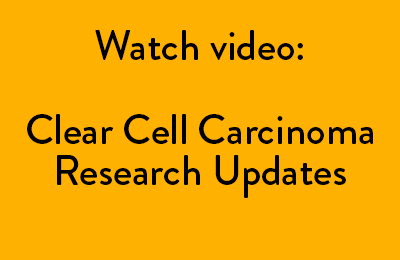
Another rare type of epithelial ovarian cancer, clear cell carcinoma accounts for 5-10% of all ovarian cancers, and is thought to often arise from endometriosis within the peritoneal cavity. As with mucinous carcinoma, most patients present with early-stage disease, and prognosis when caught in early stages is similar to prognosis for high-grade serous, while prognosis for disease caught in advanced stages tends to be worse.
There are several key pathways and potential targets for clear cell carcinoma:
- An ARID1A mutation is present in about 50% of clear cell carcinomas, which can be effectively targeted by drugs such as tazemetostat.
- 30-40% of clear cell carcinomas have a PI3K/AKT/mTOR pathway aberration, which can be targeted by P13K/AKT inhibitors.
- The angiogenesis pathway is active, making bevacizumab a potential treatment option.
- These tumors frequently express PD-1 or PD-L1, which can be targeted by immune checkpoint inhibitors.
- There are also several additional potential targets, which need further study.
Research into clear cell carcinoma is of particular promise, with the advent of immune checkpoint therapies and several ongoing clinical trials. It is expected that once these trials are completed, immune checkpoint therapies may become a new standard of care for women with clear cell carcinoma.
- A recent trial compared a regimen of irinotecan/cisplatin versus the standard of paclitaxel/carboplatin, and found no difference in outcome.
- Another trial investigated treatment of paclitaxel/carboplatin with the addition of the mTOR inhibitor temsirolimus and temsirolimus maintenance, which did not show an advantage over standard therapy.
- 3 individual studies investigated treatment through various targeted agents for recurrent clear cell carcinoma, and found no benefit.
- A 2015 study showed promising results with nivolumab, an immunotherapy agent—an early indicator that immune checkpoint inhibitors may be effective against clear cell carcinoma. Now, a 2020 trial is investigating treatment of multiple types of recurrent ovarian cancer with either nivolumab, or nivolumab plus ipilimumab. Patients with clear cell carcinoma who received the combination appear to have a significantly better response rate compared to other subtypes of ovarian cancer. Several trials are ongoing in the study of immune checkpoint inhibitors with clear cell carcinoma.
Low Grade Serous Carcinoma (LGSOC)

Low grade serous carcinoma, another rare type of epithelial ovarian cancer, accounts for 10% of serous cancers of the ovary. It can arise on its own, or following diagnosis of serous borderline tumors, and is typically diagnosed in young patients. Low grade serous carcinoma can be relatively chemo-resistant, responsive to endocrine therapy, and patients typically have more prolonged survival compared to high-grade serous ovarian cancer patients. Most patients present with advanced-stage disease, and over 70% recur.
Experts now know that the MAP kinase pathway plays a prominent role in the development of low grade serous carcinoma.
- 20-40% of low grade serous carcinomas have a KRAS mutation, which can be targeted by MEK inhibitors.
- 5-10% have a BRAF mutation, which can be targeted by BRAF inhibitors.
- Up to 26% have an NRAS mutation.
- Additionally, over 90% express the estrogen receptor, and may be responsive to hormonal therapies like aromatase inhibitors.
- Bevacizumab may also be effective in targeting the angiogenesis pathway.
Following primary surgery, patients with low grade serous carcinoma tend to be less responsive to chemotherapy than those with high grade serous carcinoma. This is true for adjuvant and neoadjuvant chemotherapy, as well as for maintenance therapy, or therapy for recurrence. This doesn’t mean that LGSOC is completely unresponsive to chemotherapy, it is just not as frequently responsive as HGSOC.
Current research into LGSOC is focused on determining the efficacy of MEK inhibitors, and further exploring endocrine therapies.
- Two studies show that patients with recurrent LGSOC who receive bevacizumab as a single agent or in combination with chemotherapy have up to a 40-50% response rate.
- Three studies show that endocrine therapies, like letrozole/anastrozole, are also active agents. A large proportion of patients may have stable disease for several months or several years. Tamoxifen is also shown to have activity for LGSOC, though it is believed to be less active than aromatase inhibitors. While it may be a treatment option, it would not typically take precedent over an aromatase inhibitor.
- A retrospective study showed significant improvement in progression-free survival for patients who received hormonal maintenance therapy following chemotherapy, compared to those who received chemotherapy alone; another retrospective study showed promising results for patients who followed up surgery with hormonal therapy alone, without chemotherapy.
- Those studies serve as a background for a current trial for patients with Stage 2-4 LGSOC. The study investigates use of paclitaxel/carboplatin followed by maintenance letrozole, versus the endocrine letrozole monotherapy. Results are about 5 years away, and if the study is positive it may lead to a shift toward abandoning chemotherapy in favor of letrozole.
- Several additional trials are ongoing, and seek to determine the efficacy of MEK inhibitors for patients with LGSCOC. It is anticipated that MEK inhibitors may eventually represent a new standard of care for this subset of patients, but more information is needed.
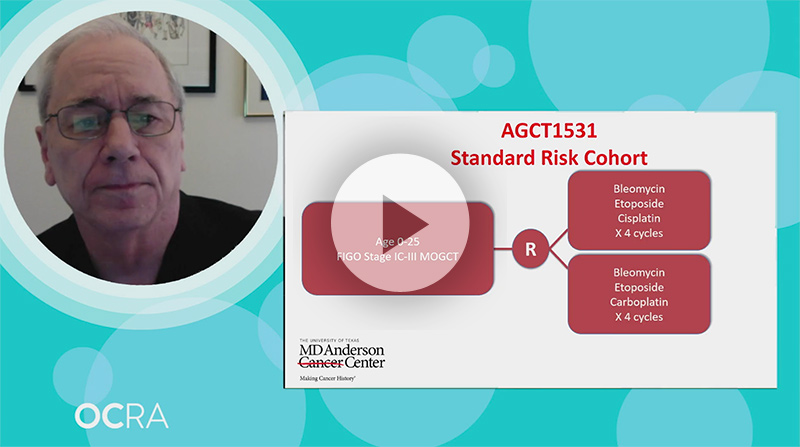
For more information and details on research progress surrounding rare ovarian cancers, watch the video Rare Ovarian Cancers, presented by Dr. David Gershenson at OCRA’s virtual National Conference.

